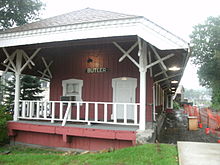Butler’s, New Jersey: Beginning

Richard Butler, a hardworking businessman from New York travelled to what was known as West Bloomingdale and bought into an existing rubber factory. In 1879, he became the president of the Rubber Comb and Jewelry Company (later named the Butler Hard Rubber Company). In 1881, a post office was built and named “Butler” to honor Richard Butler, whose improvements to the Rubber Mill caused the extensive growth of the town. Shortly after, the existing railroad stop has its name changed to the Butler Railroad Station. The expanding hard rubber factory drew in hundreds of workers, and many of them decided to live and build in this one-time vacation spot. Roads were laid out, homes, stores, a hotel and a public hall were built and land was donated by Richard Butler for the Butler Methodist Church, Saint Anthony’s Church and to the Board of Education. Legislature took notice of the expansion and separated it from Pequannock by making it a Borough on March 13, 1901.
Interesting FactsAbout Richard Butler
- Richard Butler was a good friend of Frederic August Bartholdi, the designer and builder of the Statue of Liberty.
- The Richard Butler Middle School raised enough money to help construct the entire base of the Statue of Liberty.
- Richard Butler was one of the founders of the Metropolitan Museum of Art.
- William Kiel was asked by Richard Butler to come from Europe to be the superintendent of the hard rubber company and then became the first mayor.
- On April 11th, 1902 Kiel donated money to change the swamp in the middle of town to the borough park.
- Paul Witteck, the son-in-law of William Kiel became the 2nd mayor and has a road named after him.
- Studio 13 Inc., an art studio that was located in Butler was responsible for creating a few famous pieces for clients. Werner and Erika Neubling owned the studio and created the cage located in the Golden Nugget Casino in Atlantic City and the 120-foot space needle in front of the Smithsonian Air and Space Museum.
I Bet You Didn’t Know…
- The Butler Rubber Mill was once the largest hard rubber factory in the world.
- The factories main offices are located in New York City, but the Butler office was managed by Paul Witteck, who later became a mayor.
- Butler is 38 miles from New York City by railroad.
- There are 4 churches in Butler: the Methodist Episcopal Church, St. Paul’s Protestant Episcopal Church, St. Anthony’s Roman Catholic Church, and the Baptist church.
- Butler is one of the few towns that have its own private water company.
- There are 4 volunteer fire companies: Kinney Hose, Kiel Hook and Ladder Co., Bartholdi Hose and Pequannock Hose.
- The famous Butler wooden fireman was rescued on April 2nd, 1910 by John Williams and John Spellman from a Newark salvage company. They later rebuilt and donated it to the Butler Fire Departments.
- Gifford Street is named after an American landscape painter, Sanford R. Gifford. He was another friend of Richard Butler who always desired to live in this community, but died before he could fulfill his dream.
- Butler was one of the first communities in the area to develop their own coat of arms. Every part of the coat of arms in some way represents a part of this town’s history. The royal blue and gold are the same colors that represent the high school and the State of New Jersey. The heart-shaped shield with the straight top is the kind awarded in 1628 to Sir Thomas Butler, a baronet of County Carlow, Ireland. It has a gold chief on a blue field surrounded by an ermine border. The helmet is that of a contemporary baronet. The broken hunting arrows of the crest memorialize the Lenni Lenape Indians, whose villages and trails were located where Butler is today. The scroll contains the Latin phrase “Portas ad Lacus”, which translates as “Gateway to the Lakes”. The front supporter of the shield is a golden Statue of Liberty, commemorating Richard Butler’s involvement with the committee for erecting the statue’s pedestal and his friendship with Frederic Bartholdi. The other supporter is the blue-coated wooden fireman from a Newark salvage company. The mount everything stands on is composed of 3 layers. The bottom black layer represents the Pequannock River (Lenni Lenape for “black waters”). The middle layer is gold, representing the farmlands of wheat that were once in the area. The blue top layer signifies the foothills of the Ramapo Mountains. Underneath the coat is “Borough of Butler – March 13, 1901”, the date of the town’s incorporation.

